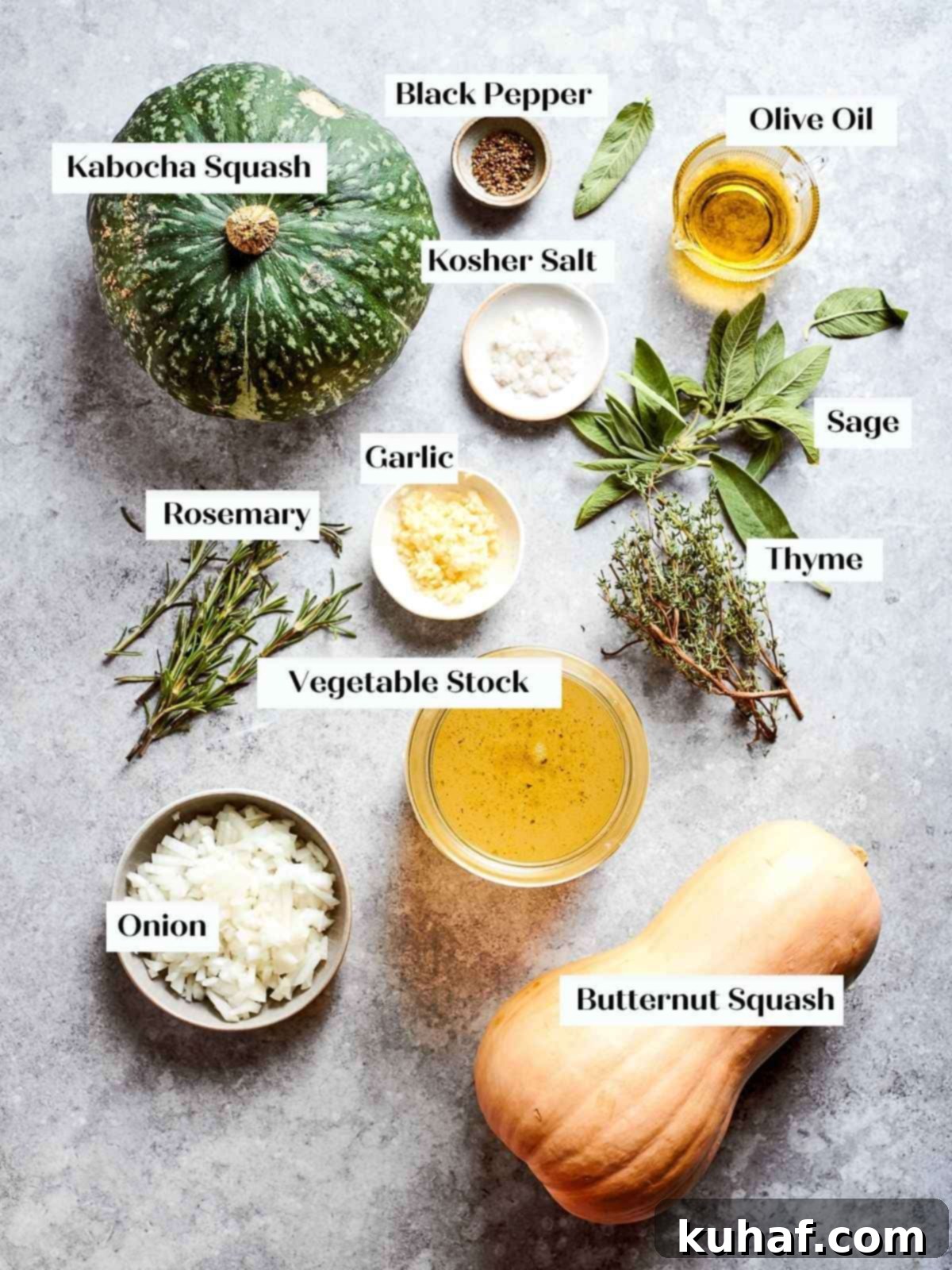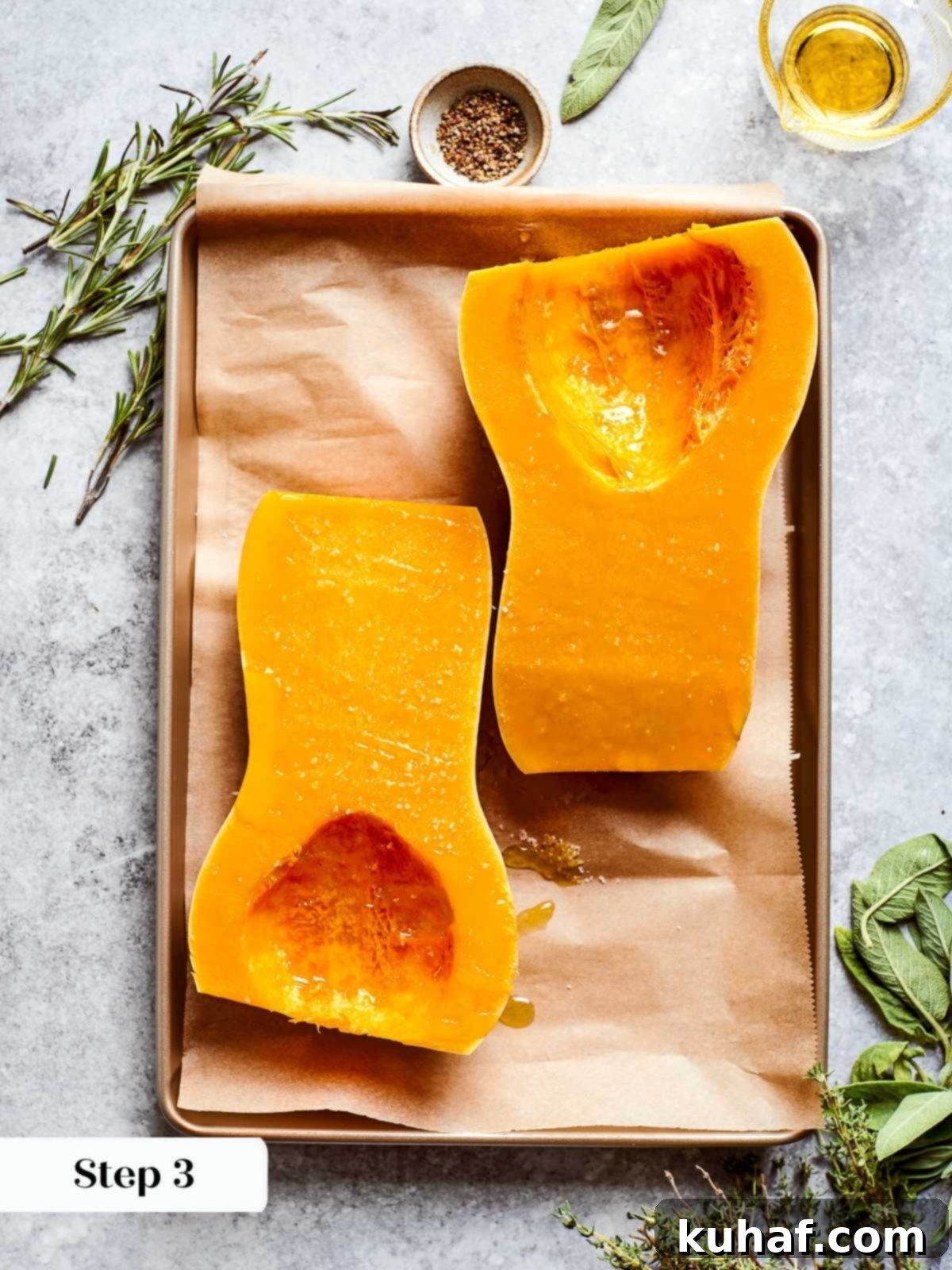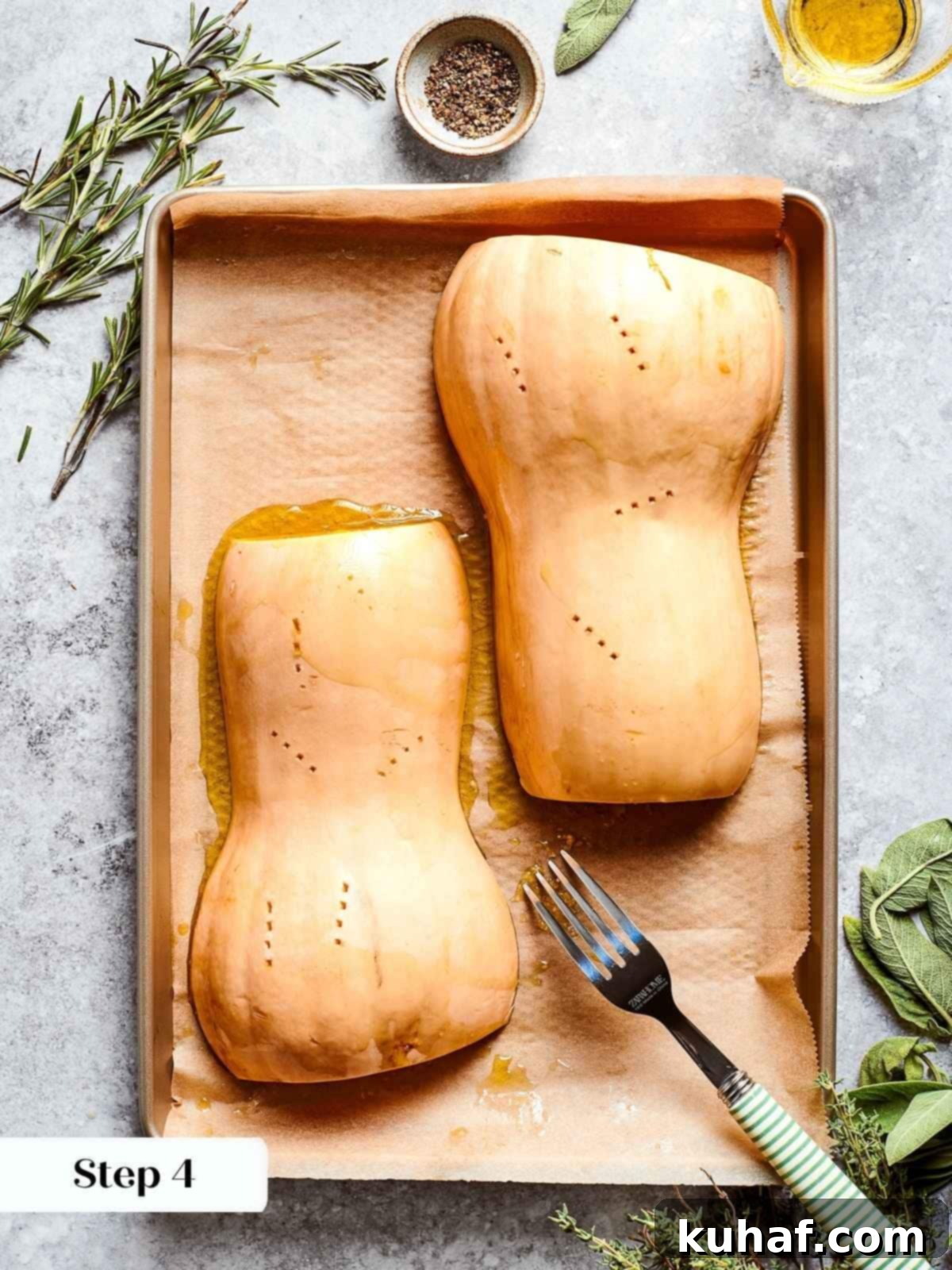Creamy Roasted Squash Soup: An Easy Vegan Recipe for Cozy Fall & Winter Comfort
Discover the secret to a velvety, deeply flavorful squash soup recipe that’s perfect for chilly days. This nourishing soup masterfully combines the natural sweetness of roasted butternut squash with the rich, creamy texture of kabocha or Blue Hubbard squash, enhanced by fresh herbs, aromatic onion, and garlic. It’s not just a meal; it’s a comforting embrace in a bowl, making it my favorite easy, healthy, and satisfying vegan lunch or dinner option.

A Quick Look at The Recipe
- Prep Time: 15 minutes
- Cook Time: 40 minutes
- Total Time: 55 minutes
- Servings: 6 bowls
- Calories: ~120 kcal (based on nutrition panel)
- Technique: Slow-roast squash to develop deep flavor, sauté aromatics, then blend to perfection.
- Flavor Profile: Smooth, subtly sweet, and vibrant with fresh herb notes, offering natural warmth.
- Difficulty: Easy and straightforward, ideal for beginners and seasoned cooks alike.
Why You Will Love This Creamy Roasted Squash Soup
- Bold, Cozy Flavor from Two Squash Varieties: This recipe elevates standard squash soup by incorporating both butternut and kabocha (or Blue Hubbard) squash. Butternut offers a natural, caramelized sweetness when roasted, while kabocha contributes a distinct richness and a naturally silky texture. Together, they create a flavor profile that’s surprisingly complex and deeply comforting, making this soup much more than the sum of its simple ingredients. It’s a harmonious blend that truly captures the essence of autumn and winter.
- Velvety-Smooth Texture Every Time: Achieving that perfectly smooth, luxurious texture is key to an exceptional squash soup. Our method guarantees it. By carefully slow-roasting the squash, blending with vegetable stock gradually, and peeling the squash when warm, you get a consistently velvety consistency reminiscent of a gourmet restaurant soup, without any grittiness. This meticulous approach ensures a delightful mouthfeel in every spoonful.
- Fresh Herbs for Unrivaled Depth of Flavor: While many creamy squash soups rely on heavy cream for richness, this vegan recipe achieves its incredible depth and flavor through a generous mix of fresh herbs. Sage, thyme, and rosemary are sautéed to release their fragrant oils, infusing the soup with an herbaceous warmth that perfectly complements the squash. This herb-forward approach creates a vibrant and complex taste that feels both indulgent and wonderfully light. A crunchy garnish of spiced pepitas further enhances the experience, adding a delightful textural contrast.
Featured Comment
⭐⭐⭐⭐⭐ “This soup was absolutely incredible! The advice about adjusting roasting time for different squash sizes was so helpful, especially since the squashes at my market are huge. I was amazed at how creamy this vegan recipe turned out. It’s definitely earned a permanent spot in my fall and winter meal rotation!” —Lauren
Table of Contents
- A Quick Look at The Recipe
- Why You Will Love This
- Ingredients & Substitutions
- How to Choose the Best Squash for Soup
- Variations for Creamy Butternut Squash Soup
- Professional Tips for the Perfect Soup
- How to Make Roasted Squash Soup
- How to Roast Butternut Squash
- How to Roast Kabocha or Blue Hubbard Squash
- How to Finish the Roasted Squash Soup
- How to Make Spiced Roasted Pepitas
- Chef Lindsey’s Recipe Tip
- Recipe FAQs
- Recommended Squash Recipes
- Squash Soup Recipe Card
- Before You Go
This roasted squash soup recipe has become a staple in my kitchen, particularly during the colder months. I find myself making it, or some delicious variation, multiple times a month because it’s consistently cozy, wonderfully silky, and incredibly reliable. The act of roasting the squash is transformative, intensifying its natural sugars and yielding a depth of sweetness that simply boiling can’t achieve. Coupled with the fragrant blend of fresh herbs, the resulting flavor is both profound and deeply comforting.
While fresh, roasted squash is always my first choice for its superior flavor, this recipe is flexible enough to accommodate canned butternut squash puree if you’re short on time. Regardless of your squash source, don’t forget the garnishes! A sprinkle of spiced pepitas, a swirl of high-quality olive oil, or a handful of homemade croutons can add a delightful textural contrast and visual appeal to each bowl.
If this warm, inviting soup has you craving more winter comfort food, you might also enjoy exploring my hearty rosemary lamb stew recipe, flavorful quinoa vegetarian meatballs, or a robust red chili with ground beef. Each offers its own unique brand of warmth and satisfaction for your cooler weather culinary adventures.
Key Ingredients & Smart Substitutions for the Best Squash Soup

Crafting a truly exceptional squash soup starts with selecting the right ingredients. Here’s a closer look at what you’ll need and how you can adapt the recipe to your pantry or preferences:
- Vegetable Stock or Vegetable Broth: This forms the liquid base of our soup. Choose a high-quality vegetable stock or broth for the best flavor. If you’re mindful of sodium intake, opt for a low-sodium variety, adjusting the salt later to your taste.
- Kosher Salt: I prefer using kosher salt in my cooking because its larger flakes make it less dense and therefore less intensely salty per teaspoon compared to table salt. This allows for more control over seasoning.
- Butternut Squash: The star of the show, providing essential sweetness and a creamy foundation. For tips on how to choose the best butternut squash, see the section below.
- Onions: Sweet, white, or yellow onions all work beautifully to build the aromatic base of this soup. I most frequently reach for yellow or sweet onions for their balanced flavor, which also happens to be my go-to choice for my renowned Best French Onion Soup!
- Garlic: Fresh minced garlic is indispensable for adding a pungent depth and aromatic warmth that truly defines the soup’s character.
- Olive Oil: Used for roasting the squash and gently sautéing the aromatics. A good quality extra virgin olive oil adds to the overall flavor. Avocado oil is an excellent alternative if you prefer a different fat or have dietary restrictions.
- Black Pepper: Freshly ground black pepper adds a subtle heat and aromatic complexity that balances the sweetness of the squash.
- Roasted Kabocha Squash or Blue Hubbard: These varieties are crucial for achieving the soup’s signature velvety texture and adding another layer of earthy flavor. Kabocha, often called “Japanese pumpkin,” offers a dense, slightly drier flesh that blends incredibly smooth, while Blue Hubbard provides a rich, sweet, and nutty profile. If you can only find one type of squash, you can certainly make a delicious soup, but the combination truly elevates the experience.
- Fresh Sage, Thyme, and Rosemary: These woody herbs are the flavor heroes of this soup, imparting a deep, earthy, and aromatic essence. Cooking them briefly in olive oil helps to “bloom” and intensify their flavors, ensuring they don’t get lost in the liquid. While fresh herbs are highly recommended for their vibrant taste, you can use dried herbs in a pinch. If using dried, add them along with the garlic and onion to give them time to soften and release their flavors.
- Pepitas (Roasted Pumpkin Seeds): These are an optional but highly recommended garnish, offering a delightful crunch and nutty flavor contrast to the smooth soup. You can also use homemade croutons for a similar textural benefit. If you happen to have leftover pumpkin dinner rolls or pumpkin challah, they’d make fantastic croutons!
Refer to the complete recipe card below for precise measurements and quantities.
How to Choose the Best Butternut Squash for Soup
Selecting the perfect squash is the first step towards a superb soup. Here’s what you need to know:
- Size Variability and Recipe Adjustment: Unlike canned ingredients, fresh produce, especially squash, comes in a wide range of sizes. This can make standardizing a recipe tricky, but don’t worry! I’ve written the recipe in cups (4 cups = 1 quart) to provide a consistent measure. You can confidently use a larger squash; just be prepared to adjust your seasonings and liquid as needed.
- Seasoning & Stock Adjustments: For a larger squash, you might opt for a slightly bigger onion and a generous, rounded tablespoon of minced garlic. Don’t be afraid to add a few more sprigs of fresh herbs. Most importantly, anticipate needing more vegetable stock to achieve your desired soup consistency, as a larger squash will naturally produce a thicker puree.
- Picking the Perfect Squash: When you’re at the market, look for a butternut squash that has a uniform, creamy beige skin with no green patches. It should feel notably heavy for its size, indicating dense, moist flesh inside. Avoid squashes with soft spots or blemishes. Once you’ve mastered picking the best squash, why not grab a few extra to make my delicious vegan butternut squash chili next?
Creative Variations for Creamy Butternut Squash Soup
While this recipe stands strong on its own, it also provides a fantastic canvas for culinary creativity. Here are a few ways to customize your creamy butternut squash soup:
- Incorporate Different Root Vegetables: To add more complexity or simply use what you have on hand, consider swapping some of the squash for other root vegetables. Parsnips will lend an earthy, slightly spicy sweetness, while russet potatoes or sweet potatoes can enhance the creaminess and subtle sweetness. Add them to the roasting pan alongside the squash.
- Add a Touch of Tart Apple: For a delightful sweet-tangy lift, especially fitting for autumn, try adding a tart apple like a Granny Smith. Core and chop the apple, then roast it alongside the squash. The apple’s acidity will brighten the soup’s flavor profile and add an intriguing dimension.
- Homemade vs. Store-Bought Pepitas: You might be wondering if you can use the seeds freshly scooped from your squash for the topping. Absolutely! However, cleaning, drying, and roasting them can be quite time-consuming. Store-bought pepitas (which are hull-less pumpkin seeds) are already prepped and offer a consistently tender crunch that’s often more palatable than roasted whole pumpkin seeds. It’s a convenient shortcut that doesn’t compromise on flavor or texture, allowing you to enjoy your soup sooner!

Professional Tips for the Perfect Roasted Squash Soup
Achieve restaurant-quality results at home with these expert tips:
- Roast for Flavor, Not Just Softness: The goal of roasting the squash isn’t merely to cook it until tender; it’s to develop deep, complex flavors through caramelization. Placing the squash cut-side down on the baking sheet allows the natural sugars to brown and caramelize, creating a rich sweetness. This crucial step prevents the soup from tasting watery or bland, building a foundation of intense flavor.
- Best Practice: Peel the Squash: While the skin of certain squashes like kabocha can become soft enough to eat when baked covered, for a truly silky-smooth soup, it’s best to remove it. Peeling the squash *after* it has been roasted is significantly easier than peeling it raw. The heat softens the skin, making it simple to scoop out the tender flesh. If you let it cool completely, it’s still manageable, but warm is optimal for ease.
- Add the Stock in Stages During Blending: To control the consistency and achieve that perfect creamy, viscous texture, add your vegetable stock gradually as you blend the soup. Starting with less stock ensures the soup remains thick and prevents it from becoming too thin too quickly. You can always add more liquid until it reaches your desired pourable, yet substantial, consistency. This technique allows for precise control over the final product.
How to Make Roasted Squash Soup: Step-by-Step Guide
Follow these detailed instructions to create a delicious and perfectly smooth roasted squash soup every time! Full measurements and further details are available in the recipe card below.
How to Roast Butternut Squash for Soup:
Step 1: Preheat the oven to 350°F (175°C).
I choose to slow roast butternut squash at a slightly lower temperature to allow for gentle caramelization and deeper flavor development. This slow-roasting is optional; feel free to adjust the temperature if you’re pressed for time, but note the flavor difference!
Step 2: Prepare the butternut squash. With a large, sharp chef’s knife, carefully slice off both the top and bottom ends of the butternut squash. Stand the squash upright on one of the newly cut flat surfaces to create a stable base. This makes it much safer to slice the squash in half lengthwise. Firmly push down on the top of the knife, keeping your fingers well clear of the blade, to cut the squash into two halves.


Step 3: Scoop out the seeds. Using a spoon, scoop out the seeds and fibrous strands from the center of each squash half. You can discard them, or set them aside if you plan to clean and roast them for a crunchy snack later (photo 1).
Step 4: Season and prepare for roasting. Line a baking sheet with parchment paper to prevent sticking and aid cleanup. Place the squash halves cut side up on the lined baking pan. Drizzle generously with olive oil and sprinkle with kosher salt. Then, flip them over so they are cut side down. Using a fork or the tip of your knife (exercise caution!), poke several holes along the length of the squash skin. This allows steam to escape, ensuring even cooking and aiding in caramelization (photo 2).
Step 5: Roast until tender. Transfer the baking sheet to the preheated oven. Bake until the squash is very soft; you should be able to press it easily with your finger or pierce it with no resistance using a paring knife. Roasting time can vary significantly based on the size of your squash, typically ranging from 25 to 40 minutes.
Step 6: Remove flesh. Once roasted and slightly cooled (it’s easiest to handle when still warm), scoop all the soft, tender butternut squash flesh from the skins. Set the roasted flesh aside, or if preparing ahead, cool it completely and store it in an airtight container in the refrigerator.
How to Roast Kabocha or Blue Hubbard Squash for Soup:
Step 7: Preheat the oven to 350°F (175°C).
Step 8: Prepare the kabocha squash. Similar to butternut, carefully cut off the top and bottom of the kabocha squash with a large chef’s knife. Stand it upright on a flat cut surface. Now, cut the squash in half lengthwise. Kabocha and Blue Hubbard squashes have very thick, tough rinds, so this step might require significant force. Be extremely careful and keep your fingers clear of the blade. For a sturdy cut, you can even pick up the squash and firmly bang it down on the cutting board while pushing the knife through, ensuring your hands are safe!
Honestly, a meat cleaver would be an even better tool for these tough squashes, but I don’t own one. If your grocery store offers them pre-cut by the half, consider it a true culinary blessing and opt for those! Paying a little extra is often worth saving the effort and ensuring safety. Trust me on this one.
Step 9: Scoop out seeds. Remove the seeds and stringy bits from the squash halves. Discard them, or set aside if you wish to clean and roast them later.



Step 10: Cut into pieces. Working with one half of the squash at a time, slice it into strips approximately 2 inches wide. Then, cut each strip into roughly 2-inch pieces. Exact uniformity isn’t critical, but similar sizes will ensure even cooking. Repeat this process with the other half if you have it (photo 3).
Step 11: Arrange on a baking sheet for roasting. Place all the squash pieces skin-side down (with the cut side facing up!) onto a baking sheet lined with parchment paper. It’s okay if the pieces are close together; they don’t need much space. Sprinkle them with a little kosher salt, then cover the squash with another piece of parchment paper, followed by a large sheet of aluminum foil. Crimp and seal the foil tightly around the edges of the baking pan to create a steamy environment.
Depending on the amount of squash you’re cooking and your available bakeware, you can also use a large roasting pan or baking dish for this step.
Step 12: Bake until tender. Bake in the preheated oven until the squash is completely soft and can be effortlessly pierced with a cake tester or paring knife. This usually takes about 25 minutes. Carefully remove the baking sheet from the oven, then remove the top layer of parchment paper and aluminum foil.
How to Finish the Roasted Squash Soup:
For the best results, use a Dutch oven or a thick-bottomed skillet to prepare your soup base. Heat the olive oil over medium heat until it shimmers and is hot, but not smoking.
Step 13: Sweat the aromatics. In your medium sauce pot or Dutch oven, add 2 tablespoons of olive oil, the diced onion, and the fresh herbs (rosemary, sage, thyme). Reduce the heat to medium-low and gently sweat the herbs and onion until they become almost translucent. Sweating ensures their flavors are released without browning (photo 4).
“Sweating” is a culinary term for cooking aromatics slowly over low heat, allowing them to release their moisture and soften without developing any color or caramelization. This gentle process extracts maximum flavor.
Step 14: Add the garlic. Incorporate the minced garlic into the pot. If the onions begin to stick even on low heat, add a tiny bit more olive oil. Continue to sweat the mixture until the onions are completely transparent and fragrant (photo 5).




Step 15: Combine squash and stock. Add the roasted squash flesh to the pot along with half of the vegetable stock. Let it gently simmer over medium-low heat, allowing the tender squash to begin breaking down and melding its flavors with the stock (photos 6 & 7).
Step 16: Blend until smooth. Using an immersion blender, carefully blend the soup directly in the pot. Add the remaining stock gradually, a little at a time, until the soup reaches your desired consistency – smooth, pourable, yet wonderfully viscous and creamy (photo 8)!
If you don’t have an immersion blender, you can purée the soup in a traditional stand blender. Be sure to work in batches, never exceeding the maximum fill line. When blending hot liquids, always leave the pour spout open (or remove the center cap of the lid) to allow steam to escape. You can cover the opening with a folded kitchen towel to prevent hot splatters. Just like with an immersion blender, gradually add stock to achieve your preferred thickness.
Step 17: Season to taste. Taste the soup carefully for seasoning. Add fresh ground black pepper and kosher salt as needed to enhance all the flavors, ensuring a perfectly balanced and delicious result.
How to Make Spiced Roasted Pepitas:
Step 18: Toss and prepare seeds. In a medium-sized bowl, toss the raw pumpkin seeds (pepitas) with olive oil, a pinch of salt, and your chosen spices (smoked paprika, ground cumin, cayenne pepper if using, and brown sugar). Spread the coated seeds in an even layer onto a baking pan lined with parchment paper.
Step 19: Roast until golden. Place the baking sheet in the oven and roast the pepitas, stirring or tossing them frequently to ensure even browning. Keep a close eye on them; once they lose their glossy sheen, appear matte, and have developed a beautiful golden-brown color and fragrant aroma, remove them from the oven. Let them cool completely on the baking sheet, where they will crisp up further (photo 9).
Step 20: Serve and enjoy! Ladle the warm, creamy squash soup into individual bowls. Garnish each serving generously with the spiced roasted pepitas and/or homemade croutons for a delightful crunch and added flavor (photo 10).
Chef Lindsey’s Recipe Tip
When working with kabocha or similar thick-skinned squashes like Blue Hubbard, it’s virtually impossible to scoop the soft flesh cleanly from the skin as you would with butternut or pumpkin. Instead, after roasting, you’ll need to scrape the tender orange flesh away from the skin of each individual piece. Don’t worry about removing every last bit of skin or the slightly greener areas where the flesh transitions; it won’t impact the final taste or texture of your beautifully blended soup!
Recipe FAQs: Your Questions Answered
This roasted squash soup is famously delicious the next day, as the flavors have more time to meld. To store leftovers, transfer the cooled soup to an airtight container and refrigerate it promptly. It will stay fresh and flavorful for 3-5 days. For longer storage, this soup also freezes exceptionally well.
For individual servings, simply reheat the soup in the microwave in 30-second intervals, stirring between each, until it’s heated through to your desired temperature. For larger quantities, gently warm the soup in a saucepan over medium-low heat on the stovetop, stirring occasionally, until it’s hot throughout.
Absolutely! Squash soup freezes beautifully. To freeze, allow the soup to cool completely after cooking. Then, transfer it to freezer-safe containers or heavy-duty freezer bags, leaving about an inch of headspace for expansion. It can be frozen for up to 3 months. When you’re ready to enjoy it, thaw the soup overnight in the refrigerator before reheating gently on the stovetop or in the microwave.

More Delicious Squash Recipes to Try
Easy Side Dish Recipes
Roasted Spiced Butternut Squash
Date Night
Vegan Butternut Squash Chili
Easy Side Dish Recipes
Brown Sugar Baked Acorn Squash Halves
Winter Dinner Recipes
Twice Baked Spaghetti Squash with Turkey Sausage Meat Sauce
If you tried this delicious creamy roasted squash soup recipe and absolutely loved it, please take a moment to leave a 🌟 star rating and share your thoughts in the comments below. I genuinely love hearing from you and your feedback truly brightens my day!

Roasted Squash Soup
Pin Recipe
Comment
Print Recipe
Ingredients
- 3-4 cups roasted butternut squash
- ½ roasted kabocha squash or Blue Hubbard, peeled after roasting
- 4 cups vegetable stock (32 ounces, preferably low-sodium)
- 2 tablespoons fresh rosemary (finely minced)
- 1-2 tablespoons fresh sage (chopped)
- 1 tablespoon fresh thyme (leaves picked)
- 1 small onion (finely chopped / small dice)
- 1 tablespoon minced garlic
- 2 tablespoons olive oil
- kosher salt to taste
- black pepper to taste
For the Spiced Pepitas:
- ½ cup raw pumpkin seeds (pepitas)
- 1 teaspoon olive oil
- ½ teaspoon smoked paprika
- ¼ teaspoon ground cumin
- ¼ teaspoon cayenne pepper (optional, for heat)
- ½ teaspoon brown sugar
- ¼ teaspoon kosher salt
Instructions
How to Roast Butternut Squash for Soup:
-
Preheat your oven to 350°F (175°C).
-
Carefully cut the top and bottom ends off the butternut squash using a large chef’s knife. Stand the squash upright on a cut end to create a stable base, then slice it in half lengthwise, pushing down from the top of the knife while keeping your fingers safely clear of the blade.
-
Scoop out the seeds and fibrous strands from the center of each squash half. You can discard them or save them for roasting later.
-
Line a baking sheet with parchment paper. Place the squash halves cut-side up on the baking pan, drizzle with olive oil, and sprinkle with kosher salt. Then, flip them over so the cut side is facing down. Carefully poke several holes along the length of the squash skin with a fork or the tip of your knife.
-
Place the baking sheet in the preheated oven and bake until the squash is very soft and can be easily pierced with a knife. Roasting time will vary from 25 to 40 minutes, depending on the squash’s size.
-
Once roasted and slightly cooled, scoop all the soft butternut squash flesh from the skins. Set aside for the soup or store in an airtight container in the refrigerator once fully cooled.
How to Roast Kabocha or Blue Hubbard Squash for Soup:
-
Preheat your oven to 350°F (175°C).
-
Using a large chef’s knife, carefully cut off the top and bottom of the kabocha squash. Stand it upright on a flat cut surface. Then, slice the squash in half lengthwise. Kabocha rinds are very thick, so this may require considerable force. Ensure your fingers are always clear of the blade; you can even gently bang the squash down on the cutting board while pushing the knife through to help.
-
Scoop out the seeds and stringy bits. Discard them or set aside to clean and roast if desired.
-
Working with one half at a time, cut the squash into strips about 2 inches wide, then cut each strip into roughly 2-inch pieces. The exact size isn’t critical, but aim for similar sizes for even cooking. Repeat for the other half.
-
Place all the squash pieces skin-side down (cut side facing up) on a parchment-lined baking sheet. It’s fine if they are close together. Sprinkle with a little kosher salt. Cover with another piece of parchment paper, then tightly seal with a large piece of aluminum foil, crimping the edges around the rim of the baking pan.
-
Bake in the preheated oven until the squash is soft and easily pierced with a cake tester or paring knife, typically around 25 minutes. Remove from the oven, then carefully remove the top parchment and foil.
How to Make Roasted Squash Soup:
-
In a medium sauce pot (or Dutch oven), heat 2 tablespoons of olive oil over medium-low heat. Add the finely chopped onion and fresh herbs (rosemary, sage, thyme). Gently sweat them until the onions become nearly translucent, avoiding any browning.
-
Add the minced garlic to the pot. If the onions start to stick, add a small splash more olive oil. Continue to sweat until the onions are fully transparent and fragrant.
-
Stir in the roasted squash flesh and half of the vegetable stock. Let the mixture simmer over medium-low heat for a few minutes, allowing the squash to soften further and meld with the aromatics and stock.
-
Using an immersion blender (or carefully transferring to a stand blender in batches), blend the soup directly in the pot. Gradually add the remaining vegetable stock, a little at a time, until the soup is perfectly smooth, pourable, and achieves your desired creamy consistency.
-
Taste the soup and adjust the seasoning with fresh ground black pepper and kosher salt to your preference.
How to Make Spiced Roasted Pepitas:
-
In a medium bowl, toss the raw pumpkin seeds (pepitas) with 1 teaspoon of olive oil, smoked paprika, ground cumin, cayenne pepper (if using), brown sugar, and ¼ teaspoon of kosher salt. Spread the seasoned pepitas onto a baking pan lined with parchment paper.
-
Roast the pepitas in the oven (or pan-roast on the stovetop) until they appear matte, turn golden brown, and become fragrant, stirring or tossing frequently. Remove them from the heat and let them cool completely on the baking sheet to crisp up.
-
Serve the warm squash soup in bowls, garnished generously with the spiced pepitas and/or homemade croutons. Enjoy!
Notes
Flavor Tips – If you use a standard (not reduced-sodium) vegetable stock, you might find you don’t need to add much, if any, additional salt to the soup. Always taste and adjust!
Variations – For a delightful sweet-tangy twist that’s especially lovely in autumn, try adding one tart apple (like a Granny Smith), cored and chopped, to the roasting pan alongside your squash.
Storage – Store any leftover soup in an airtight container in the refrigerator for 3-5 days. This soup also freezes exceptionally well for up to 3 months.
Nutrition
Before You Go
I sincerely hope you enjoyed creating and savoring this cozy, comforting, and healthy roasted squash soup. It’s truly one of my favorite recipes for bringing warmth to any weeknight. If you’re a fan of nourishing bowls, be sure to check out our other delicious and diverse soup and stew recipes!
